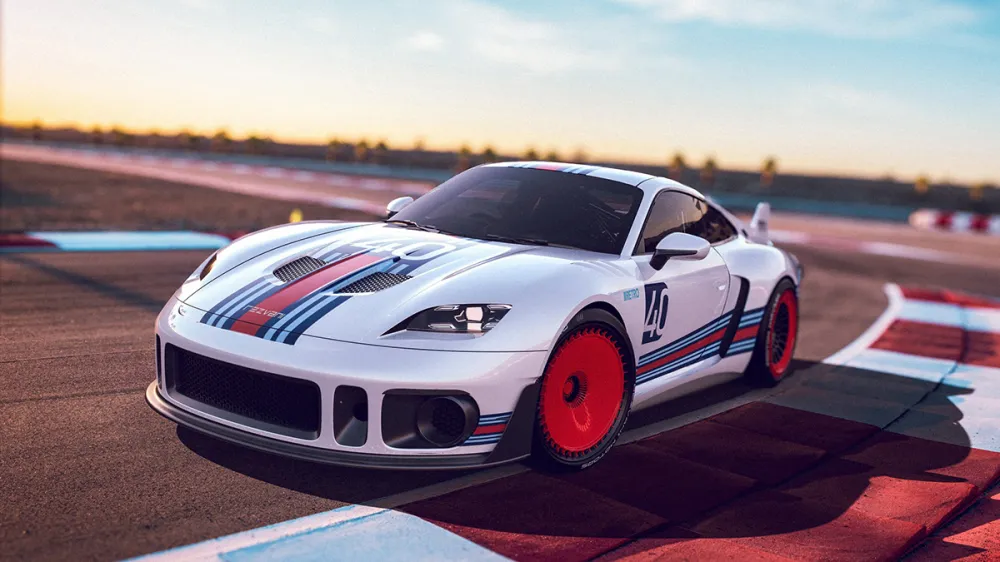
How The Major Marques Are Building Their Electric Cars
All you need to know about the move to electric cars.
Related articles
The electric car may only represent a tiny portion of the current market, but that market share is only poised to experience growth – so we decided to take a deep dive into how the major marques build their electric cars.
With Porsche, Mercedes-Benz, Jaguar, and Audi all tossing well-made hats into Tesla’s ring, the electric drivetrain is being evolved in a number of unique ways, based on the manufacturers’ philosophies for what the electric car should be.
The specific components and applications may vary, but the basic tenets of an electric chassis largely remain the same: the combustion engine is replaced by electric motors, powered by a controller that draws juice from a series of rechargeable batteries. That much you knew, right? But if we dive a little deeper, there’s some fascinating science happening beneath the floorboards of EVs. (Bear in mind, what comes next is oversimplified because we’re not engineers, nor do we wish to beleaguer you in technical jargon. (Also, a hat tip to this Donut Media video for helping our edification.)
Electricity itself cannot be stored in a battery, but electrical energy can be housed within the chemicals of the battery. Those two-node terminals are comprised of different metals, separated by an electrolyte which helps bring the chemicals from the nodes together in harmonious equilibrium, forming an electrical circuit and producing energy.

Battery assembly at the Audi plant in Brussels. Photo: Courtesy of Audi AG.
If you popped an EV onto a lift and started dismantling the battery pack from the chassis, you’d get down to individual battery cells. These are metal cases housing long spirals of two metal sheets separated by a thin perforated plastic sheet. The sheet that acts as the positive node is made of lithium cobalt oxide, while the negative node sheet is carbon. The whole setup is soaked in organic material, like ether, that functions as the electrolyte. While the cell is charging, lithium ions move through the ether and attach to the carbon. When the battery is discharging, they move back home.
So how does the car actually move? Magnetism. When you send an electrical current through a series of wrapped wires or other metal conduction bar, you generate a magnetic field. The forces from that field can actuate motion in an induction motor. There are two basic parts to this kind of motor: the rotor and the stator. The rotor houses the conduction bars and the stator provides alternating current (AC) to move the rotor. The speed of the rotor comes from the frequency of the AC. Mash the throttle on an EV and you’re increasing the AC. This system requires an inverter module, which sits near the battery and converts the direct current into AC to drive the motor. Because the rotor and the stator don’t physically connect—rotor bearings keep them separate—there’s less wear and tear than in a combustion engine.

The Performance Battery Plus, with 93.4 kWh, found in Porsche’s Taycan Turbo S. Photo: Courtesy of Porsche AG.
Also, unlike combustion engines, electric motors can produce vicious amounts of torque immediately, and all the way up to 20,000 rpm. Due to this, there’s not a need for a transmission or torque converter. Further, a combustion engine uses pistons to create side-to-side motion that must be converted into forward movement, electric motors typically only produce rotational force, which is far easier to translate into forward motion. Lastly, the beauty of an induction motor is that when it’s not employed to move the wheels forth, it can harness the speed of the wheels to act as an alternator and recharge the battery system under freewheeling or braking.
This fundamental architecture can be invariably tweaked for a variety of applications. When Porsche was designing the newly-launched Taycan Turbo and Turbo S, the German marque didn’t want to veer far from its sports car heritage. Eschewing “green driving” attributes in favour of repeatable, blistering performance meant the wizards in Stuttgart gave it a massive 800-volt system, doubling the 400 volt systems found in other EVs, which helps increase performance and aids in diminishing charging times since it can handle higher power flowing into the battery pack. (The Taycan can charge at a peak energy transfer of 270 kW, meaning you can take the battery from five to 80 per cent in about 23 minutes on a high-speed DC charger.)

The Porsche Taycan Turbo S. Photo: Courtesy of Porsche AG.
Porsche also used innovative drive motors, one mounted on each axle, that have “hairpin” winding in the stator coils. These wires are rectangular instead of round and bent into a hairpin shape before being affixed to the stator core by laser beam welds. The design means more densely-packed wiring which affords more copper in the stator. That translates to more power and torque without enlarging the stator itself. While it doesn’t technically need one, the Taycan also includes a two-speed transmission on the rear axle, which realises quicker acceleration from a standstill in first gear, and a long ratio in second gear promises higher efficiency and higher power reserves, especially when travelling at breakneck speeds.
The Taycan uses permanently excited synchronous motors, which differ from the induction motors described above. That goofy name means it uses AC and DC current to keep the rotor speed and the speed of the stator equal, whereas in the induction motor, the rotor is always lagging behind the stator a bit. (For reference, Tesla uses induction motors.) The synchronous motors in the Taycan are more efficient than induction motors of the same output and voltage rating, and they also realize higher constant power over the entire speed range.

A diagram of one of the permanently excited synchronous motor on the Porsche Taycan Turbo S. Photo: Courtesy of Porsche AG.
The sum of all of this is a 750hp electric missile (in the Turbo S. The Turbo boasts 616hp) and 775 ft-lbs of torque that’ll launch the car from zero to 100km/h in 2.6 seconds. As we noted when reviewing the Taycan during a first-drive, it’s absurdly fast. But that’s precisely what Porsche sought during the engineering phase.

The 800-volt on-board power supply in the Taycan Turbo S. Photo: Courtesy of Porsche AG.
Mercedes-Benz launched its eSUV, the EQC, this year—the first salvo in a barrage of 10 EVs forthcoming from the tri-star marque over the next three years. Here, the focus was to make a smooth and silent car that still ticks the right Merc hallmarks of quality, safety and comfort. It required tranquillity from the drivetrain to help customers who are making the jump from combustion to electric. Employed on each axle is an induction motor and, in concert, 402 hp and 561 ft-lbs of torque are generated, which is more than ample to get the 2400 kilogram hauling.

The 2020 Mercedes-Benz EQC. Photo: Courtesy of Mercedes-Benz.
“Performance is very easy in an EV,” says Dr. Martin Hermsen, senior manager, E-Drive Development & System Integration, who was responsible for the EQC’s drivetrain engineering. “You need a very large battery to reach the requirement for the range, and with this large battery, you have enough power. The question becomes how you will use this power? We put the motor, inverter, and differential all in the same housing, one on each axle, but the front motor is more efficient while the rear system is more for power,” says Hermsen. The 405-volt EQC can adjust in real time to shift between the front and rear motors—or employ both—depending on how you’re driving. Both motors will kick in when you’re in sport mode or are really stepping on it. Relaxed drivers will only see the front motor engaged.
And it’s indeed a remarkably smooth ride when you’re not lead-footing it. We tested the EQC in a three-country jaunt from Copenhagen to Berlin and found it approachable and intuitive, especially when you’re trying to maximise the 350-kilometre range in eco mode. “When you buy an EV, your belief is that it should be a green driving vehicle. We wanted to deliver that,” says Hermsen. Steering wheel paddles typically reserved for shifting gears are repurposed in the EQC to toggle between regeneration modes. (The EQC does not feature a transmission at all.)

Positioning of the on-board charger, electric drive modules and lithium-ion battery in the EQC. Photo: Courtesy of Mercedes-Benz.
When you lift off the accelerator, the recuperation of energy starts. In D+ mode, the lightest setting, the recuperation feels like very mild engine braking while the wheels convert and feed energy back to the 80 kWh battery pack. In D-, lift off the accelerator and you’ll feel the EQC’s prow drop as it regains even more energy from the wheels. In D – -, the highest setting, the Mercedes slows so much, traditional combustion engine drivers may feel like something’s gone wrong, but the vehicle is trying to capture as much energy as possible.
In this mode, one-pedal driving is enabled, meaning you needn’t touch the brakes at all if you’re doing it right. “We use a lot of data, including traffic patterns and the car’s camera systems to help achieve the most intelligent and efficient driving possible,” says Hermsen. One-pedal driving may take a little getting used to for new EV drivers, but there’s a gamification aspect to the affair that makes it addicting. You’re constantly trying to see how much energy you can recoup and how long you can go without having to employ the brake pedal.
Mercedes-Benz pledges that its whole portfolio of vehicles will be electrified (fully or partially) by 2022, and the point of the EQC is to make the transition from combustion to pure electric as seamless as possible. For the customers who want the full green experience, it’s a wonderful one. For the folks who want to crank it into sport mode and rip, it’s equally happy to comply.
Audi also chose to launch its first EV in the form of an SUV, the e-tron, for similar reasons to Mercedes-Benz. It cited a need for new EV purchasers to feel comfortable with the vehicle, and the most acceptable body styling was a ute. “We kept the traditional SUV shape,” says Matt Mostafaei, Audi Connected Vehicle and e-tron product manager, “which hurts in terms of efficiency, but helps with the familiar feeling.”

The Audi e-tron 55 quattro. Photo: Courtesy of Audi AG.
Underpinning the e-tron is a 95 kWh battery pack—good for 396 volts—that feeds energy to dual induction motors, a smaller one driving the front axle, and a larger motor in the rear. Combined, they generate 402 hp and up to 490 ft-lbs of torque (when using an electrical boost feature). Those induction motors were chosen because of the “advantage to decouple the axle to eliminate drag while freewheeling,” says Mostafaei. “The motors bolster our philosophy that the e-tron should feel as normal as possible to drive.”
That freewheeling means Audi wasn’t as concerned with one-pedal green driving. “Using the brake pedal is the most natural thing for a driver going electric,” says Mostafaei. So, Audi wisely reimagined the braking system. When you hit the brakes on the e-tron, a small fluid reservoir behind the firewall fills up, mimicking the feel of traditional hydraulic brakes. However, 90 per cent of the time, the brake-by-wire system is actually engaging the motors to slow the wheels down. If the stopping event is under .03 gs, the car can recuperate energy without you feeling much of anything. (The e-tron does know when the friction brakes are required during harder stops, and they work perfectly in those scenarios.)

Brake recuperation in the Audi e-tron 55 quattro. Photo: Courtesy of Audi AG.
We’ve driven the e-tron several times and this clever setup works so well, you’ll never know when the motors are slowing you versus the actual brake rotors. Like the EQC, there are also regeneration paddles, which can also help bolster the recuperation. And the whole system can tack on an additional 30 per cent to the e-tron’s range, which is about 200 miles.
Audi also rethought the shape of the cells within the battery pack. “We use pouch cells instead of the common cylindrical cells,” Mostafaei explains. “They’re cheaper, easier to source and lighter. We can monitor the temperature better, too. They also have more surface area so you can condition the battery better for faster charging.” The e-tron can get up to an 80 per cent state of charge in about 27 minutes on a 150 kW DC fast charger. Mostafaei further adds that Audi is experimenting with the chemistry within the battery to help improve the life cycle of the cells.
The e-tron can also manipulate its ride height to help increase efficiency, dropping down to reduce drag or raise up if you need to plow through some snow or venture off-road, where it is surprisingly capable. “Had efficiency been our sole goal, we wouldn’t have added roof rails and heated seats and enlarged the cargo bay,” says Mostafaei. “But we want you to live with the e-tron as you would any other SUV.” Next for Audi is the e-tron GT, a four-door performance sedan that will semi-rival Porsche’s Taycan. Of the car due out next year, Mostafaei claims: “It’ll be a sporty car, but still will focus on luxury and comfort as well.”
Subscribe to the Newsletter
Recommended for you
8 Fascinating Facts You Didn’t Know About Aston Martin
The British sports car company is most famous as the vehicle of choice for James Bond, but Aston Martin has an interesting history beyond 007.
May 1, 2024
Rezvani Will Rebuild Your 911 to Go From Zero to 100 in Two Seconds
The shop will build a version of the RR1 based on the Carrera S, GT3, and Turbo S
By Bryan Hood
April 23, 2024
You may also like.
You may also like.
8 Fascinating Facts You Didn’t Know About Aston Martin
The British sports car company is most famous as the vehicle of choice for James Bond, but Aston Martin has an interesting history beyond 007.
Aston Martin will forever be associated with James Bond, ever since everyone’s favourite spy took delivery of his signature silver DB5 in the 1964 film Goldfinger. But there’s a lot more to the history of this famed British sports car brand beyond its association with the fictional British Secret Service agent.
Let’s dive into the long and colourful history of Aston Martin.
You may also like.
What Venice’s New Tourist Tax Means for Your Next Trip
The Italian city will now charge visitors an entry fee during peak season.
Visiting the Floating City just got a bit more expensive.
Venice is officially the first metropolis in the world to start implementing a day-trip fee in an effort to help the Italian hot spot combat overtourism during peak season, The Associated Press reported. The new program, which went into effect, requires travellers to cough up roughly €5 (about $AUD8.50) per person before they can explore the city’s canals and historic sites. Back in January, Venice also announced that starting in June, it would cap the size of tourist groups to 25 people and prohibit loudspeakers in the city centre and the islands of Murano, Burano, and Torcello.
“We need to find a new balance between the tourists and residents,’ Simone Venturini, the city’s top tourism official, told AP News. “We need to safeguard the spaces of the residents, of course, and we need to discourage the arrival of day-trippers on some particular days.”
During this trial phase, the fee only applies to the 29 days deemed the busiest—between April 25 and July 14—and tickets will remain valid from 8:30 am to 4 pm. Visitors under 14 years of age will be allowed in free of charge in addition to guests with hotel reservations. However, the latter must apply online beforehand to request an exemption. Day-trippers can also pre-pay for tickets online via the city’s official tourism site or snap them up in person at the Santa Lucia train station.
“With courage and great humility, we are introducing this system because we want to give a future to Venice and leave this heritage of humanity to future generations,” Venice Mayor Luigi Brugnaro said in a statement on X (formerly known as Twitter) regarding the city’s much-talked-about entry fee.
Despite the mayor’s backing, it’s apparent that residents weren’t totally pleased with the program. The regulation led to protests and riots outside of the train station, The Independent reported. “We are against this measure because it will do nothing to stop overtourism,” resident Cristina Romieri told the outlet. “Moreover, it is such a complex regulation with so many exceptions that it will also be difficult to enforce it.”
While Venice is the first city to carry out the new day-tripper fee, several other European locales have introduced or raised tourist taxes to fend off large crowds and boost the local economy. Most recently, Barcelona increased its city-wide tourist tax. Similarly, you’ll have to pay an extra “climate crisis resilience” tax if you plan on visiting Greece that will fund the country’s disaster recovery projects.
You may also like.
Omega Reveals a New Speedmaster Ahead of the Paris 2024 Olympics
Your first look at the new Speedmaster Chronoscope, designed in the colour theme of the Paris Olympics.
The starters are on the blocks, and with less than 100 days to go until the Paris 2024 Olympics, luxury Swiss watchmaker Omega was bound to release something spectacular to mark its bragging rights as the official timekeeper for the Summer Games. Enter the new 43mm Speedmaster Chronoscope, available in new colourways—gold, black, and white—in line with the colour theme of the Olympic Games in Paris this July.
So, what do we get in this nicely-wrapped, Olympics-inspired package? Technically, there are four new podium-worthy iterations of the iconic Speedmaster.

The new versions present handsomely in stainless steel or 18K Moonshine Gold—the brand’s proprietary yellow gold known for its enduring shine. The steel version has an anodised aluminium bezel and a stainless steel bracelet or vintage-inspired perforated leather strap. The Moonshine Gold iteration boasts a ceramic bezel; it will most likely appease Speedy collectors, particularly those with an affinity for Omega’s long-standing role as stewards of the Olympic Games.
Notably, each watch bears an attractive white opaline dial; the background to three dark grey timing scales in a 1940s “snail” design. Of course, this Speedmaster Chronoscope is special in its own right. For the most part, the overall look of the Speedmaster has remained true to its 1957 origins. This Speedmaster, however, adopts Omega’s Chronoscope design from 2021, including the storied tachymeter scale, along with a telemeter, and pulsometer scale—essentially, three different measurements on the wrist.
While the technical nature of this timepiece won’t interest some, others will revel in its theatrics. Turn over each timepiece, and instead of a transparent crystal caseback, there is a stamped medallion featuring a mirror-polished Paris 2024 logo, along with “Paris 2024” and the Olympic Rings—a subtle nod to this year’s games.
Powering this Olympiad offering—and ensuring the greatest level of accuracy—is the Co-Axial Master Chronometer Calibre 9908 and 9909, certified by METAS.

A Speedmaster to commemorate the Olympic Games was as sure a bet as Mondo Deplantis winning gold in the men’s pole vault—especially after Omega revealed its Olympic-edition Seamaster Diver 300m “Paris 2024” last year—but they delivered a great addition to the legacy collection, without gimmickry.
However, the all-gold Speedmaster is 85K at the top end of the scale, which is a lot of money for a watch of this stature. By comparison, the immaculate Speedmaster Moonshine gold with a sun-brushed green PVD “step” dial is 15K cheaper, albeit without the Chronoscope complications.
—
The Omega Speedmaster Chronoscope in stainless steel with a leather strap is priced at $15,725; stainless steel with steel bracelet at $16,275; 18k Moonshine Gold on leather strap $54,325; and 18k Moonshine Gold with matching gold bracelet $85,350, available at Omega boutiques now.
Discover the collection here
You may also like.
Here’s What Goes Into Making Jay-Z’s $1,800 Champagne
We put Armand de Brignac Blanc de Noirs Assemblage No. 4 under the microsope.
In our quest to locate the most exclusive and exciting wines for our readers, we usually ask the question, “How many bottles of this were made?” Often, we get a general response based on an annual average, although many Champagne houses simply respond, “We do not wish to communicate our quantities.” As far as we’re concerned, that’s pretty much like pleading the Fifth on the witness stand; yes, you’re not incriminating yourself, but anyone paying attention knows you’re probably guilty of something. In the case of some Champagne houses, that something is making a whole lot of bottles—millions of them—while creating an illusion of rarity.
We received the exact opposite reply regarding Armand de Brignac Blanc de Noirs Assemblage No. 4. Yasmin Allen, the company’s president and CEO, told us only 7,328 bottles would be released of this Pinot Noir offering. It’s good to know that with a sticker price of around $1,800, it’s highly limited, but it still makes one wonder what’s so exceptional about it.
Known by its nickname, Ace of Spades, for its distinctive and decorative metallic packaging, Armand de Brignac is owned by Louis Vuitton Moët Hennessy and Jay-Z and is produced by Champagne Cattier. Each bottle of Assemblage No. 4 is numbered; a small plate on the back reads “Assemblage Four, [X,XXX]/7,328, Disgorged: 20 April, 2023.” Prior to disgorgement, it spent seven years in the bottle on lees after primary fermentation mostly in stainless steel with a small amount in concrete. That’s the longest of the house’s Champagnes spent on the lees, but Allen says the winemaking team tasted along the way and would have disgorged earlier than planned if they’d felt the time was right.
Chef de cave, Alexandre Cattier, says the wine is sourced from some of the best Premier and Grand Cru Pinot Noir–producing villages in the Champagne region, including Chigny-les-Roses, Verzenay, Rilly-la-Montagne, Verzy, Ludes, Mailly-Champagne, and Ville-sur-Arce in the Aube département. This is considered a multi-vintage expression, using wine from a consecutive trio of vintages—2013, 2014, and 2015—to create an “intense and rich” blend. Seventy percent of the offering is from 2015 (hailed as one of the finest vintages in recent memory), with 15 percent each from the other two years.

This precisely crafted Champagne uses only the tête de cuvée juice, a highly selective extraction process. As Allen points out, “the winemakers solely take the first and freshest portion of the gentle cuvée grape press,” which assures that the finished wine will be the highest quality. Armand de Brignac used grapes from various sites and three different vintages so the final product would reflect the house signature style. This is the fourth release in a series that began with Assemblage No. 1. “Testing different levels of intensity of aromas with the balance of red and dark fruits has been a guiding principle between the Blanc de Noirs that followed,” Allen explains.
The CEO recommends allowing the Assemblage No. 4 to linger in your glass for a while, telling us, “Your palette will go on a journey, evolving from one incredible aroma to the next as the wine warms in your glass where it will open up to an extraordinary length.” We found it to have a gorgeous bouquet of raspberry and Mission fig with hints of river rock; as it opened, notes of toasted almond and just-baked brioche became noticeable. With striking acidity and a vein of minerality, it has luscious nectarine, passion fruit, candied orange peel, and red plum flavors with touches of beeswax and a whiff of baking spices on the enduring finish. We enjoyed our bottle with a roast chicken rubbed with butter and herbes de Provence and savored the final, extremely rare sip with a bit of Stilton. Unfortunately, the pairing possibilities are not infinite with this release; there are only 7,327 more ways to enjoy yours.
You may also like.
Bill Henson Show Opens at Roslyn Oxley9 Gallery
Dark, grainy and full of shadows Bill Henson’s latest show draws on 35 mm colour film shot in New York City in 1989.
Bill Henson is one of Australia’s best-known contemporary photographers. When a show by this calibre of artist opens here, the art world waits with bated breath to see what he will unveil.
This time, he presents a historically important landscape series that chronicles a time in New York City that no longer exists. It’s a nostalgic trip back in time, a nocturnal odyssey through the frenetic, neon-lit streets of a long-lost America.
Known for his chiaroscuro style, Henson’s cinematic photographs often transform his subject into ambiguous objects of beauty. This time round, the show presents a mysterious walk through the streets of Manhattan, evoking a seedy, yet beautiful vision of the city.


Relying on generative gaps, these landscapes result from Henson mining his archive of negatives and manipulating them to produce a finished print. Sometimes, they are composed by a principle of magnification, with Henson honing in on details, and sometimes, they are created through areas of black being expanded to make the scene more cinematic and foreboding. Like silence in a film or the pause in a pulse, the black suggests the things you can’t see.




Henson’s illustrious career has spanned four decades and was memorably marred by controversy over a series of nude adolescent photographs shown in 2008, which made him front-page news for weeks. This series of portraits made Henson the subject of a police investigation during which no offence was found.
In recent years, Henson has been a sharp critic of cancel culture, encouraging artists to contribute something that will have lasting value and add to the conversation, rather than tearing down the past.

His work deals with the liminal space between the mystical and the real, the seen and unseen, the boundary between youth and adulthood.
His famous Paris Opera Project, 1990-91, pictured above, is similarly intense as the current show, dwelling on the border between the painterly and the cinematic.
Bill Henson’s ‘The Liquid Night’ runs until 11 May 2024 at Roslyn Oxley9 Gallery.
Roslyn Oxley9 Gallery, 8 Soudan Ln, Paddington NSW; roslynoxley9.com.au


























